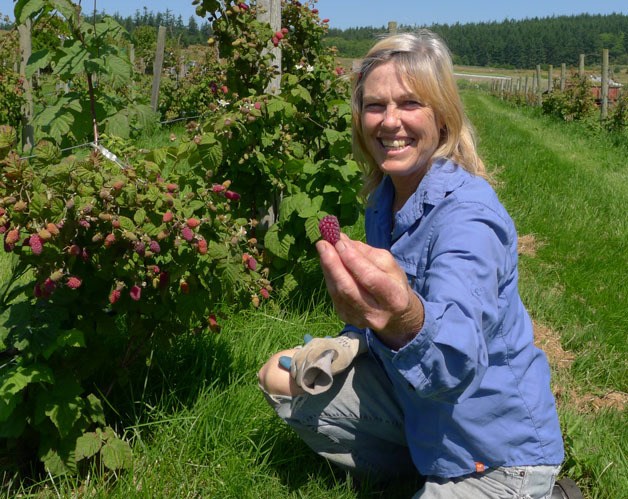At one time the Greenbank Farm was home to more than 100 acres of loganberries, which made it the largest grower of the raspberry/blackberry hybrid in the country.
Now, however, the Greenbank Farm is down to one patch that covers about a half an acre. The farm’s groundskeeper, Paula Sherwood, has been working to improve the conditions at the patch, which would mean more loganberries; however, she is struggling to find volunteers to help with the labor-intensive work that is needed.
She has been busy for the past several years trying to remove the weeds that are growing in the patch along with the plants. The weed pulling has proven to be time intensive and is one of the more immediate issues that is threatening the berries.
When Sherwood started work two years ago on the loganberry patch, it was overgrown with grass and weeds. It had been several years since anyone had tended to the patch. It was tough to knock down the weeds and grass without further damaging the berries. She had to get organic soil from Mount Vernon and there is a continual drainage problem at the patch.
Despite the decline of the loganberry at the Greenbank Farm, it still maintains a visible part of Whidbey Island. The Greenbank Farm hosted its annual Loganberry Festival last weekend, and Sherwood is willing to take visitors into the patch to collect ripened berries.
“It’s a nice walk through history,” Sherwood said.
In addition to the popular festival, area businesses use the loganberries to produce pies, wine and a liqueur.
The current loganberry patch was planted at the Greenbank Farm about 10 years ago, said Michael Seraphinoff, a Greenbank resident who was part of the volunteer group that planted the loganberries. He managed the patch for about five years. He had tried to find someone a bit younger to take over the responsibility but couldn’t find anyone willing. His work on the patch ended in about 2007.
Seraphinoff said he was disappointed not to see many people on the island get excited about loganberries.
He said the farm used to grow about 140 acres of the luscious loganberries. However, in the 1990s, before the farm became publicly owned, the previous owner started pulling the bushes out of the ground.
Sherwood has had some help with the farm’s loganberries. The farm received an anonymous donation and she said the head of the farmer training center provided tips to help improve the patch. In addition, she found an area resident who is willing to provide her with plants that will help fill in the gaps.
“To find those was kind of a cool blessing,” Sherwood said.
Judy Feldman, manager of the Greenbank Farm, said there was talk of having the farmer training center students help out with the patch, but that it would be difficult to incorporate it into the students’ coursework. The training center is just one of the changes that have taken place at the farm over the years. In addition to the students, the farm is also home to art galleries, several small businesses and a newly installed solar power array.
Sherwood said she would like the grass in the loganberry patch removed because it competes with the bushes for the water and nutrients.
Ideally, she would like to see the patch moved up the hill where the drainage is better. She is also looking for volunteers to help control the weeds in the current patch. She noted that the work is time consuming and labor intensive.
For more information about volunteering at the loganberry patch, contact Sherwood at 206-713-9024.


